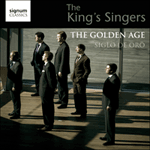
Welcome to Hyperion Records, a British classical label devoted to presenting high-quality recordings of music of all styles and from all periods from the twelfth century to the twenty-first.
Hyperion offers both CDs, and downloads in a number of formats. The site is also available in several languages.
Please use the dropdown buttons to set your preferred options, or use the checkbox to accept the defaults.

| The King's Singers» More |
Lobo’s polyphonic settings of appropriate sections of the responsorial chant and its verses survive in a manuscript still in the Toledo Cathedral archives (Libro de coro No 24). To revive it, one needs plainchant of the period. Fortunately, we have these sections in the margin of a manuscript, originally from Lerma in the province of Burgos, now in the library of the Hispanic Society of America. This states that it follows the canto llano (plainchant) of El Escorial according to the Use of Toledo. Lobo was master of the music at Toledo from 1593 to 1604. Our reconstruction has the chant and polyphony put together in responsorial form, with its verses and repeats.
from notes by Bruno Turner © 1998
Les mises en musique polyphoniques de sections ad hoc du chant responsorial et de ses versets nous sont parvenues dans un manuscrit qui n’a pas quitté les archives de la cathédrale de Tolède (Libro de coro no 24). Mais faire revivre cette œuvre de Lobo ne saurait se faire sans le plain-chant de l’époque. Par bonheur, nous disposons de ces sections dans la marge d’un manuscrit originaire de Lerma (province de Burgos), mais conservé à la bibliothèque de l’Hispanic Society of America. Il établit que le canto llano (plain-chant) d’El Escorial est suivi, selon l’usage de Tolède. Lobo fut maître de musique à Tolède, de 1593 à 1604. Notre reconstitution a réuni le chant grégorien et la polyphonie sous une forme responsoriale, avec ses versets et ses répétitions.
extrait des notes rédigées par Bruno Turner © 1998
Français: Hypérion
Lobos polyphone Bearbeitung der entsprechenden Abschnitte des respondierenden Gesangs und seine Verse sind in Form eines Manuskript im Kathedralarchiv von Toledo erhalten geblieben (Libro de coro Nr. 24). Um es wiederzubeleben, bedarf es des Cantus planus jener Zeit. Glücklicherweise finden wir diese Abschnitte am Rande des Manuskripts, das ursprünglich aus Lerma in der Provinz Burgos stammt, sich nun aber in der Obhut der Bibliothek der Hispanic Society of America befindet. Darin heißt es, daß es dem canto llano (cantus planus) des El Escorial dem Kodex von Toledo entsprechend folgt. Lobo war in den Jahren 1593 bis 1604 der musikalische Meister von Toledo. In unserer Rekonstruktion sind Gesang und Polyphonie, begleitet von ihren Versen und Wiederholungen, in respondierender Form zusammengelegt.
aus dem Begleittext von Bruno Turner © 1998
Deutsch: Michael Stoffl
Las piezas polifónicas de Lobo de las secciones apropiadas del canto responsorial y sus versos se conservan en un manuscrito que sigue depositado en los archivos de la Catedral de Toledo (Libro de coro núm. 24). Para revivirlo, es necesario acudir al canto llano de la época. Afortunadamente, encontramos esas secciones en el margen de un manuscrito, procedente originalmente de Lerma (Burgos), y en la actualidad en la Hispanic Society of America. Éste señala que sigue el canto llano de El Escorial de acuerdo con el Uso Toledano. Lobo fue maestro de música en Toledo de 1593 a 1604. Nuestra reconstrucción sitúa conjuntamente en forma responsorial el canto llano y la polifonía, con sus versos y repeticiones.
extraído de las notas de Bruno Turner © 1998
Español: Luis Gago
 The Golden Age The Golden AgeThe first release in The King’s Singers 40th anniversary year celebrates music by Portuguese, Spanish and Mexican composers from the period known as the Siglo de Oro, The Golden Age.» More |

